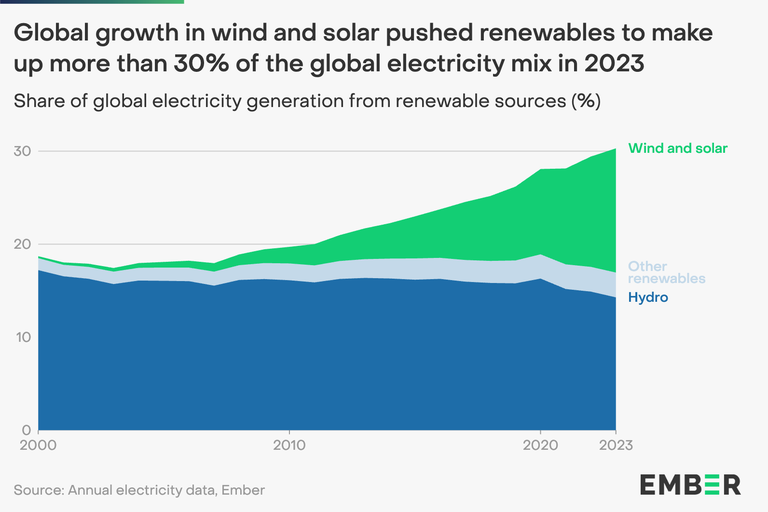https://www.lifegate.it/rinnovabili-30percento-2023
- |
- The new report from the Ember think tank on renewable sources has been released.
- More than 30 percent of global electricity production was met by renewable sources.
- Solar energy is growing faster than all other renewables.
In 2023, renewable sources generated the 30 percent of the world's electricity, thanks to the growth of solar and wind energy.This is the main news contained in the fifth edition of Global electricity review by Ember:a result that will allow 2023 to be remembered as the year that will most likely mark the peak of emissions in the energy sector.

From 2000 to today, renewables have grown from 19 to 30 percent
The energy think tank's report traces the unstoppable rise of clean energy sources:since 2000, in fact, renewables have gone from 19 percent to over 30 percent of global electricity, thanks to the increase in solar and wind energy.These two are went from 0.2 percent in 2000 to 13.4 percent in 2023, while the remaining part of the share of renewables is represented by hydroelectric.
Accordingly, in 2023 the intensity of CO2 of global electricity production has reached a new all-time low, 12 percent less than the 2007 peak.In this context, the European Union is the entity that has recorded the greatest shift away from fossil fuels among the countries that produce the most CO2 in the OECD.
Solar is growing but so is coal due to drought
Ember's report is one of the energy industry's most comprehensive, as it provides a comprehensive overview of what happened in the global energy system last year, covering electricity data from 215 countries, including the latest 2023 data for 80 villages which represent 92 percent of the demand global electricity supply.
Looking further into the relationship, we note how thesolar energy it was the main source of growth, with new electricity production more than double that of coal in 2023.Solar energy has maintained its status as the fastest growing source of electricity for the nineteenth consecutive year has surpassed wind energy becoming the largest source of new electricity for the second consecutive year.
Growth in renewable generation could have been even greater in 2023, but energy production hydroelectric power reached a five-year low to this part, due to the drought in China and other parts of the world.
Under normal conditions, the clean capacity added in 2023 would have been enough to allow a 1.1 percent decline in fossil generation.Instead, the shortage of hydroelectric power was filled by an increase in coal production, a choice that led to a 1 percent increase in emissions from the global energy sector.95 percent of the increase in coal production in 2023 occurred in four countries severely affected by drought:China, India, Vietnam and Mexico.

On emissions from the energy sector we are at the turning point
In short, all Ember data demonstrates that theelectricity is increasingly cleaner, but the sector's emissions have not yet fallen because we consume more of it.It's like saying that each TWh of electricity produces less carbon dioxide (i.e. has a lower CO2 intensity), but the increase in demand leads to an increase in total emissions, for all the reasons explained so far, mainly due to the reduction in electricity produced from hydroelectric sources and the consequent increase in coal.
This proves that Progress is being made in decarbonizing electricity, but clean electricity is not yet growing fast enough to outpace demand growth and reduce emissions.“The pace of emissions decline depends on how quickly the renewables revolution continues,” explained Dave Jones, Global insights program director at Ember.

And now the world is close to this turning point:we could finally be atbeginning of a new era of emissions reduction of the energy sector, with a projected 2 percent decrease in global fossil fuel production in 2024.What is certain is that clean electricity has already contributed to slow the growth of fossil fuels by nearly two-thirds in the last ten years.
At the UN climate change conference Cop 28, held in December, world leaders reached a historic agreement for triple global capacity of renewables by 2030.The goal calls for the world to reach 60 percent renewable electricity by that year, thus halving the energy sector's emissions and putting it on a path in line with the 1.5 degree climate target.
Therefore, growth in the renewable energy sector depends on political ambitions and incentive mechanisms, as several countries are demonstrating, including China - the first country in terms of installed renewable power, a goal that has allowed China to achieve five years in advance their renewables targets – Brazil and the Netherlands.Clean energy sources are changing the global economy:a great contribution, if not the greatest, to mitigating the effects of climate change.
